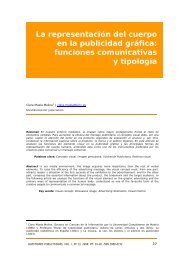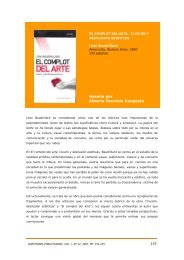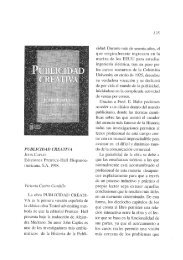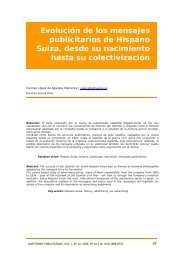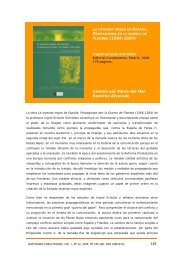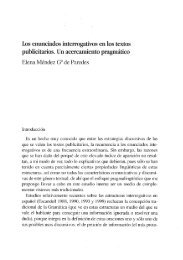Análisis de un caso de propaganda bélica antijaponesa - Maecei.es
Análisis de un caso de propaganda bélica antijaponesa - Maecei.es
Análisis de un caso de propaganda bélica antijaponesa - Maecei.es
You also want an ePaper? Increase the reach of your titles
YUMPU automatically turns print PDFs into web optimized ePapers that Google loves.
JESÚS JIMÉNEZ-VAREAtanto al Peligro Amarillo en su sentido <strong>de</strong> horda, como al villano individual, pu<strong>es</strong> separa a<strong>un</strong>o <strong>de</strong> la masa para hacerlo objeto <strong>de</strong>l ataque singular <strong>de</strong>l protagonista. De <strong>es</strong>e modo, laimagen refiere al motivo clásico <strong>de</strong> la princ<strong>es</strong>a r<strong>es</strong>catada <strong>de</strong> <strong>un</strong> monstruo por <strong>un</strong> héroe, <strong>de</strong> laque pue<strong>de</strong>n encontrarse numerosísimos ejemplos durante siglos: Perseo a bordo <strong>de</strong> Pegaso<strong>de</strong>scien<strong>de</strong> <strong>de</strong>l cielo para salvar a la enca<strong>de</strong>nada Andrómeda <strong>de</strong> <strong>un</strong> monstruo marino;Heracl<strong>es</strong> libera a H<strong>es</strong>íone <strong>de</strong> Troya, hija <strong>de</strong>l rey Lameodonte, <strong>de</strong> su ca<strong>de</strong>nas y mata a lacriatura que la amenaza; en la epopeya hindú Ramayana, el héroe Rama, con la ayuda <strong>de</strong>ldios-mono Hanuman, acu<strong>de</strong> al r<strong>es</strong>cate <strong>de</strong> Sita, abducida por el rey-<strong>de</strong>monio Ravana; laleyenda nacional ingl<strong>es</strong>a <strong>de</strong> San Jorge y el dragón; las innumerabl<strong>es</strong> variacion<strong>es</strong> sobre eltema en los cuentos popular<strong>es</strong> y en las novelas <strong>de</strong> caballería. Se trata <strong>de</strong> <strong>un</strong> temaimperece<strong>de</strong>ro al que los creador<strong>es</strong> <strong>de</strong> relatos no <strong>de</strong>jan <strong>de</strong> recurrir, como comentó Ecor<strong>es</strong>pecto a Jam<strong>es</strong> Bond, ligando directamente el mito <strong>de</strong>l r<strong>es</strong>cate <strong>de</strong>l dragón con el <strong>de</strong>lPeligro Amarillo:Bond is the knight and the villain is the dragon; […] lady and villain stand for beauty and thebeast; Bond r<strong>es</strong>tor<strong>es</strong> the lady to the fulln<strong>es</strong>s of spirit and to her sens<strong>es</strong> –he is the Prince whor<strong>es</strong>cu<strong>es</strong> Sleeping Beauty; between the Free World and the Soviet Union, England and the non-Anglo-Saxon co<strong>un</strong>tri<strong>es</strong> is realised the primitive epic relationship between the Privileged Raceand the Lower Race, between White and Black, Good and Bad. [Ian] Fleming is a racist in th<strong>es</strong>ense that any artist is one if, to repr<strong>es</strong>ent the Devil, he <strong>de</strong>picts him with oblique ey<strong>es</strong> (Eco,2003: 45).En la cultura occi<strong>de</strong>ntal, el dragón se erige como b<strong>es</strong>tia predilecta para encarnar al enemigo,como ya señalara Joseph Campbell: “This formula, in<strong>de</strong>ed, of the shining hero going againstthe dragon has been the great <strong>de</strong>vice of self-justification for all crusa<strong>de</strong>s” (Campbell, 2004:315). Por su parte, Estados Unidos llevaba utilizando <strong>es</strong>ta fórmula <strong>de</strong>s<strong>de</strong> ant<strong>es</strong> <strong>de</strong> suin<strong>de</strong>pen<strong>de</strong>ncia nacional para <strong>de</strong>monizar a su primer gran Otro: el nativo norteamericano.En su Magnalia Christi (1702), <strong>un</strong>a <strong>de</strong> las figuras religiosas más relevant<strong>es</strong> <strong>de</strong>l puritanismogenético <strong>de</strong>l país norteamericano, Cotton Mather, se refirió a los original<strong>es</strong> habitant<strong>es</strong> <strong>de</strong>aquellas tierras como “generations of the dragon” (en Slotkin, 1973: 155), arrojando asísobre ellos toda la carga simbólica <strong>de</strong> los enemigos <strong>de</strong>l pueblo elegido <strong>de</strong> Dios. La mismaobra incluía material perteneciente a la que se consi<strong>de</strong>ra “the first coherent myth-literature<strong>de</strong>veloped in America for American audienc<strong>es</strong>” (ibí<strong>de</strong>m: 95), las narrativas <strong>de</strong> cautiveriodon<strong>de</strong> mujer<strong>es</strong> blancas eran secu<strong>es</strong>tradas por indios y obligadas a vivir entre ellos. Estegénero gozó <strong>de</strong> enorme popularidad entre los poblador<strong>es</strong> blancos <strong>de</strong> Norteamérica, <strong>de</strong>s<strong>de</strong> laaparición <strong>de</strong> A Narrative of the Captivity and R<strong>es</strong>toration of Mrs. Mary Rowlandson (MaryRowlandson, 1682) hasta el cierre <strong>de</strong> la frontera <strong>es</strong>tado<strong>un</strong>i<strong>de</strong>nse a final<strong>es</strong> <strong>de</strong>l siglo XIX.Supu<strong>es</strong>tamente históricos o <strong>de</strong>claradamente ficticios, se trataba <strong>de</strong> relatos alegóricos en losque la <strong>de</strong>sdichada cautiva repr<strong>es</strong>entaba a toda la sociedad asentada en las tierras extrañas ylas pruebas que sufría eran las tribulacion<strong>es</strong> <strong>de</strong> todo aquel colectivo. Al principio, la víctima<strong>de</strong>l cautiverio había <strong>de</strong> buscar su propia salvación, pero tras <strong>un</strong> tiempo se introdujo en <strong>es</strong>tashistorias <strong>un</strong> giro cualitativamente distinto: la r<strong>es</strong>ponsabilidad <strong>de</strong>l r<strong>es</strong>cate se <strong>de</strong>splazó a <strong>un</strong>afigura masculina, retomando la tradición clásica <strong>de</strong>l matador <strong>de</strong> dragon<strong>es</strong> y verificando lamencionada <strong>es</strong>trategia <strong>de</strong> justificación <strong>de</strong> toda cruzada. Precisamente, entre los ejemplosQUESTIONES PUBLICITARIAS, VOL. I, Nº 15, 2010, PP. 72-98 8732 90. ISSN 1988-




